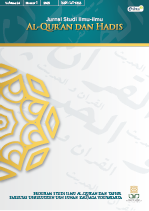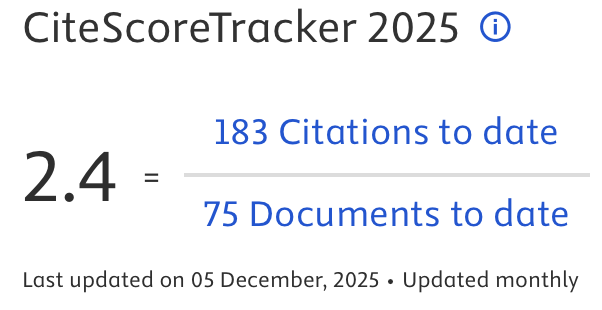The Hermeneutics of Qur’anic Translation into Sign Language: A Study of Inclusive Pedagogy by the Qur'an Indonesia Project
DOI:
https://doi.org/10.14421/qh.v25i1.5240Keywords:
Quran Indonesia Project, Inclusive Pedagogy, Quran Translation Process, the Quran, Sign LanguageAbstract
This study investigates the implementation of inclusive Qur’anic pedagogy by the Qur'an Indonesia Project (QIP), with a focus on its Sign Language translation initiative and inclusive teaching methods. QIP, in collaboration with The Little Hijabi Home Schooling, has launched QuranIDprojectISYARAT, a digital-based endeavor aiming to improve access to the Qur’an and its translations, especially for individuals with disabilities. The QuranIDProjectISYARAT program, developed by QIP, targets the deaf community and provides Qur’anic education through platforms like Instagram and YouTube, utilizing audio, visuals, and Sign Language demonstrations. While QIP utilizes Arabic Sign Language for Qur’an translation, their interpretive process prioritizes understanding Qur’anic meanings over morphemes. This study delves into QIP's Qur’an translation process and inclusive teaching practices, particularly focusing on the experiences of deaf or hearing-impaired individuals. By employing a netnography approach and conducting interviews with QIP's YouTube viewers, the research investigates interactions within QIP's online platforms and gathers insights into viewers' perspectives. The findings suggest that QIP's Qur’an translation incorporates Arabic Sign Language and volunteers' interpretations or improvisations of verses, fostering comprehension and a sense of inclusion among learners in their online Qur’anic education initiatives.
 Abstract viewed: 875 times
|
Abstract viewed: 875 times
|
 PDF downloaded = 692 times
PDF downloaded = 692 times
References
Abdel-Fattah, M. A. “Arabic Sign Language: A Perspective,” Journal of Deaf Studies and Deaf Education vol. 10 no. 2, 2005.
Abdul-Raof, H.. Qur’an Translation Discourse, Texture and Exegesis. Routledge, 2001.
Al-Hilali, H. A. M.. Al-Huruf Al-Amila fi Al-Qur’an Al-Karim: Baina Al-Nahawiyyina wa Al-Balaghiyyina. Alam al-Kutub, 1986.
Bauman, D., Rose, H., & Nelson, J. Signing the Body Poetic: Essays on American Sign Language Literature. University of California Press, 2006.
Bishop, M., & Green, M.. Philanthrocapitalism: How Giving Can Save the World. Bloomsbury Press, 2009.
Daneshgar, M. Studying the Qur’an in the Muslim Academy, 2020. https://doi.org/10.1093/OSO/9780190067540.001.0001
Deskhansa, R. S. Strategi Komunikasi Qur’an Indonesia Project Dalam Menyampaikan Al-Qur’an Berbahasa Isyarat Kepada Penyandang Tuli. Universitas Islam Negeri Syarif Hidayatullah Jakarta, 2019.
Fina, L. I. N. atu.. Studying the Qurʾan in the Context of Indonesian Islamic Higher Education. Method & Theory in the Study of Religion, 33(2), 2020, 139–161. https://doi.org/10.1163/15700682-12341508
Florian, L., & Beaton, M. Inclusive pedagogy in action: getting it right for every child. https://Doi.Org/10.1080/13603116.2017.1412513, 22, (8), 2017, 870–884. https://doi.org/10.1080/13603116.2017.1412513
Hassan, R. “Women in Islam: Qur’anic Ideals versus Muslim Realities.” Planned Parenthood Challenges, no. 2 (1995): 5–9.
Hatim, B. Communication Across Cultures: Translation Theory and Contrastive Text Linguistics. University of Exeter Press, 1997.
Hatim, B., & Mason, I. Discourse and the translator. Discourse and the Translator, 1–258, 1990.
https://doi.org/10.4324/9781315846583/DISCOURSE-TRANSLATOR-IAN-MASON-HATIM
Hayati, Siti Muna, Husnul Khitam, Zainul Erfan, and Afifah Amini. “Religious Tradition and Technology: Debate among Penghulus about Online Marriage Law in Banjarmasin.” Journal of Islamic Law 5, no. 1 (February 29, 2024): 105–24. https://doi.org/10.24260/jil.v5i1.2187.
Helmsing, A.H.J. “Conditions for Social Entrepreneurship.” The International Journal of Social Quality 5, no. 1 (2015): 51–66. http://www.jstor.org/stable/26179347.
Ikhwan, M.. An Indonesian Initiative to Make the Qur’an Down-to-Earth: Muhammad Quraish Shihab and His School of Exegesis. Freie Universität Berlin, 2015.
Millie, J.. The public metaculture of islamic preaching. The Monologic Imagination, (2017),231–249.
https://doi.org/10.1093/ACPROF:OSO/9780190652807.003.0012
Mitchell, W. J. . T. Utopian gestures. In Signing the Body Poetic: Essays on American Sign Language Literature (pp. xv–xxv). University of California Press, (2006)..
Nadhiroh, Wardatun, and Wardani. “The Dynamics of Qur’anic Text and Translation in Banjarese Ulema’s Works.” Jurnal Studi Ilmu-Ilmu Al-Qur’an Dan Hadis 24, no. 2 (July 31, 2023): 205–30. https://doi.org/10.14421/qh.v24i2.4764.
Nisa, E. F.. Creative and Lucrative Daʿwa: The Visual Culture of Instagram amongst Female Muslim Youth in Indonesia. Asiascape: Digital Asia, 5(1–2), (2018), 68–99. https://doi.org/10.1163/22142312-12340085
NURTAWAB, E. Jalalayn pedagogical practice: Styles of Qur’an and tafsir learning in contemporary Indonesia. (2018) https://doi.org/10.26180/5BDBB64ECF6BD
Official Press Release of Qur’an Indonesia Project. “Permudah Akses Teman Tuli Melalui Qur’an Indonesia Project Isyarat.” (2018).
Palfreyman, Nick. Variation in Indonesian Sign Language: A Typological and Sociolinguistic Analysis. Boston: De Gruyter, (2019).
Qatar Society For Rehabilitation and Special Needs. Al-Qamus al-Isyari al-’Arabi li al-Sum. Doha: Lajnah al-Tahdliriyyah wa al-Tansiqiyyah, (2014).
Rousseau, J.-Jacques., Herder, J. Gottfried., Moran, J. H., & Gode, Alexander.. On the Origin of Language. University of Chicago Press, (1986).
Internet:
https://quranindonesiaproject.com/#/home
https://www.youtube.com/quranindonesia
https://kitabisa.com/campaign/quranidproject/story
https://quranindonesiaproject.com/#/kabar/isi/audio-quran-dari-dan-untuk-generasi-muda-di-era-mobile
https://kitabisa.com/campaign/quranidproject/story
https://www.instagram.com/p/BnTdhwylmdo/?utm_source=qr&igsh=Zms1dXp1c214ejE2
https://youtube.com/playlist?list=PLkmaT7iel_CF3Tg8dgBLc6t3OTyAs3v0w&si=t7WCrh7-SiVcr-6e
https://youtube.com/playlist?list=PLkmaT7iel_CG69SMWp2Q0y9jnwFMg4qd8&si=N8msthE5Gv6P2ZdF
https://youtube.com/playlist?list=PLkmaT7iel_CEG6VymlRCD9YzQbwcDoKUF&si=Md7z5S95B7yLvUy8
https://www.youtube.com/watch?v=kTGzCA0uOME&list=PLkmaT7iel_CF3Tg8dgBLc6t3OTyAs3v0w
https://www.youtube.com/watch?v=jXIzTUy4pbk&list=PLkmaT7iel_CF3Tg8dgBLc6t3OTyAs3v0w&index=4
https://www.youtube.com/watch?v=YJI7S9G5C1s&list=PLkmaT7iel_CF3Tg8dgBLc6t3OTyAs3v0w&index=3
https://www.instagram.com/p/BjHcHrdAI_e/?igsh=MTc5NjR4eXA3aGpmYg==
https://www.youtube.com/watch?v=kTGzCA0uOME&list=PLkmaT7iel_CF3Tg8dgBLc6t3OTyAs3v0w&index=2
Downloads
Published
How to Cite
Issue
Section
License
Copyright (c) 2024 Muhammad Saifullah, Ratna Aryati Nurjanah

This work is licensed under a Creative Commons Attribution-NonCommercial-NoDerivatives 4.0 International License.
Publishing your paper with Jurnal Studi Ilmu-ilmu al-Qur'an dan Hadis means that the author or authors retain the copyright in the paper. Jurnal Studi Ilmu-ilmu al-Qur'an dan Hadis uses license CC-BY-NC-ND or an equivalent license as the optimal license for the publication, distribution, use, and reuse of scholarly works. This license permits anyone to copy and redistribute the material in any medium or format and must give appropriate credit, provide a link to the license, and indicate if changes were made. If you remix, translate, transform or build upon the material you may use it for private use only and not for distribution. Jurnal Studi Ilmu-ilmu al-Qur'an dan Hadis granted an exclusive non-commercial reuse license by the author(s), but the author(s) are able to put the paper onto a website, distribute it to colleagues, give it to students, use it in your thesis, etc, so long as the use is not directed at a commercial advantage or toward private monetary gain. The author(s) can reuse the figures and tables and other information contained in their paper published by Jurnal Studi Ilmu-ilmu al-Qur'an dan Hadis in future papers or work without having to ask anyone for permission, provided that the figures, tables, or other information that is included in the new paper or work properly references the published paper as the source of the figures, tables or other information, and the new paper or work is not direct at a private monetary gain or commercial advantage.
Jurnal Studi Ilmu-ilmu al-Qur'an dan Hadis journal Open Acces articles are distrubuted under the Creative Commons Attribution-NonCommercial-NoDerivatives 4.0 International (CC BY-NC-ND 4.0). Article can be read, copy and redistribute the material ini any medium or format under the following conditions:
Attribution — You must give appropriate credit, provide a link to the license, and indicate if changes were made. You may do so in any reasonable manner, but not in any way that suggests the licensor endorses you or your use.
NonCommercial — You may not use the material for commercial purposes.
NoDerivatives — If you remix, transform, or build upon the material, you may not distribute the modified material.










